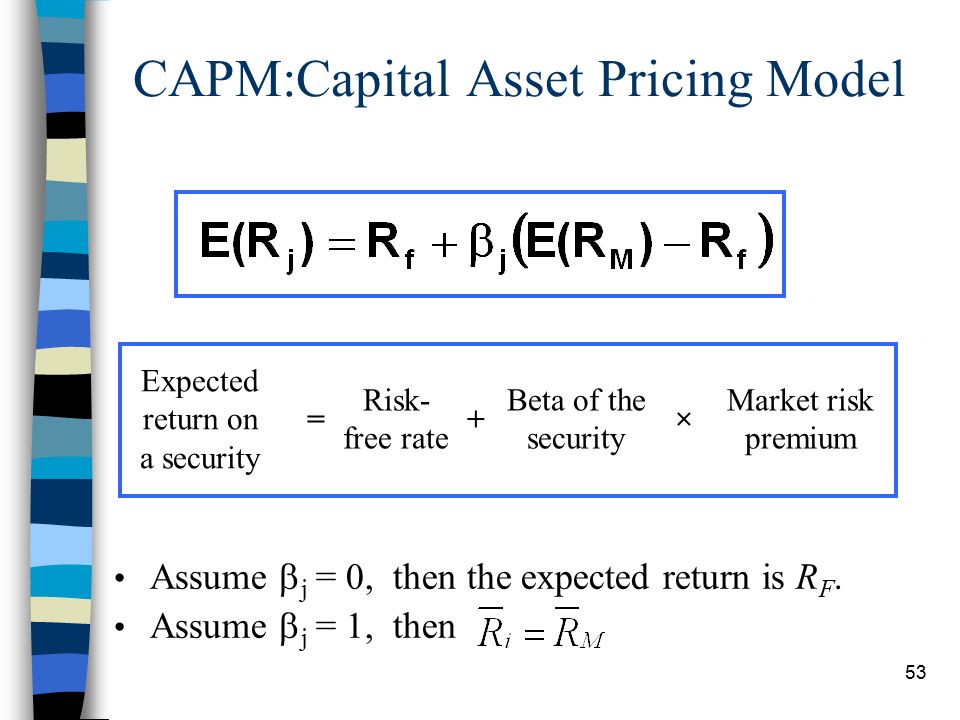Contents:


When the beta coefficient value is equal to one, it signifies the security is correlated to the stock market or indices. They have a parallel effect on the share price and returns with market fluctuations in a similar manner compared to the benchmark index. Generally, large-cap companies have a beta equal to one as they are the primary constituent of the benchmark indices. So the market itself becomes the benchmark in determining the beta of security. It helps in confirming if the stock is getting compared to the correct benchmark. Beta value is usually set at 1 being balanced, below 1 being a low beta or safer stock, and vice versa.
What Is Clean Harbors, Inc.’s (NYSE:CLH) Share Price Doing? – Simply Wall St
What Is Clean Harbors, Inc.’s (NYSE:CLH) Share Price Doing?.
Posted: Fri, 05 May 2023 13:52:57 GMT [source]
A Beta of 1.23 means that; a 1% move in the index will result in a 1.23% movement in the stock price. Beta is calculated not on the price or the index values but on the daily price returns versus the index returns. Normally, the Beta is calculated by considering price data for much longer periods of time so that the vagaries of the market can be avoided.
This is because when the stock market experiences considerable volatility and falls, investors consider gold to be a safe haven. They invest in gold to avoid losses from the stock market, and gold prices might then increase with increased demand. Standard deviation is a statistical tool that measures the deviation or dispersion of the data from the mean or average.
What is alpha and beta?
Reading the alpha of a stock is important as it indicates the possibility of its success in the future too. Understanding the BETA stock market definition can help you know how high the risk can be when investing in stocks and allow you to make informed decisions. The market has a BETA of 1.0, and the BETA ratio in stock indicates how it might move. Usually levered beta has a higher value than unlevered beta since it also factors in the risk of taking on debt. The effect of debt is calculated by multiplying the debt-equity ratio with (1 – tax rate) and then adding 1 to this value.
You would need to look at the funds you are considering and evaluate how the returns in the past relate to the Beta values. Check if your fund provided consistently high returns despite the high Beta when the market goes up for different periods. If the Beta value is low, then check if your fund provides you better protection when the market falls. It may also be possible that with a low Beta, the fund can deliver better returns than other funds in the category over a longer duration as it can better protect gains.
Here’s a tabular representation of Alpha vs Beta values
You may have certainly heard mentions of ‘can beta be negative’ and ‘beta’ during the course of your stock market research. You may even have an inkling that they pertain to technical analysis of the market and are useful tools for the informed investor. Here’s what you need to know about these indicators as well as the crucial differences between them.
It is also similar to alpha in that it shows how much more volatile a stock is than the market by way of a percentage. Beta is a numerical value and can be equal to, greater than, or less than 1. Stocks with a beta value higher than 1 are considered high beta stocks, whereas those with less than 1 are considered low beta stocks. As discussed above high and low beta, it justifies the riskiness of stock plus a very low beta or a very high beta can be detrimental for the investors.
Beta cannot be removed by diversification within the same asset class. But you can address this risk by investing in other types of assets with comparatively lower Beta values if you have already selected funds with high positive Beta values. This concept is known as asset allocation, and beta can assist you in that. Let us say, to seek gains from mutual fund investments; you have invested in different types of equity mutual funds (e.g., large-cap, mid-cap and small-cap).
Advantages of Beta Stocks
Investors assemble a portfolio of investments that is balanced and can provide them with the best possible returns while minimizing risk. Risk is a huge factor in determining one’s portfolio structure as it greatly influences the gains made or losses sustained. This is a portfolio with zero systematic risk, which is a lucrative feature for many investors.
Patch Notes of the Minecraft Bedrock Update 1.20.0.23 Beta Patch … – The Nerd Stash
Patch Notes of the Minecraft Bedrock Update 1.20.0.23 Beta Patch ….
Posted: Fri, 05 May 2023 21:38:04 GMT [source]
Alpha indicates excess return, whereas beta measures the risk or volatility of an asset. Securities having an inverse relation with stock market seem to hold negative beta coefficients. In the event of drastic stock market fluctuation or crash, investors often pool their money in these securities for higher returns. Gold is a significant example of such investment tool having a negative beta, as its value tends to rise over time. It not only poses a secure tool for investment but also acts as a hedge against inflation.
At Tickertape, I’m dedicated to presenting my learning and providing insightful suggestions to help my readers make sound investment decision. For instance, small and mid-cap companies are high beta stocks with growth potential. Purchasing such company stocks or bonds can lead to substantial returns.
There seems to be something about the securitization process that makes real assets behave more like financial assets. How your mutual fund reacts to the market risk or market movement, as a result, is measure by beta. While the Beta for an index is always 1, Beta for a fund can be 1, more than one or less than 1. VIX is a measure of implied volatility in trading of securities.
What is Unlevered Beta?
Beta sometimes referred to as the Beta coefficient, indicates persistent risk or potential dangers that cannot be prevented. It assesses the unpredictability of a share, investment, or portfolio in the marketplace. Using past data, it calculates the relationship between an investment’s motion and market fluctuations. There is a well-known argument regarding BETA as it does not differentiate between a stock’s upside or downside price movement.
- The baseline for beta is one, and any positive value would indicate that the stock price is moving as per market movements while negative values indicate the opposite.
- In simpler terms, this means that if the stock market rises, the prices of such securities might fall and vice versa.
- While positive Beta funds play a huge role in growing your investment, negative Beta funds have a role in asset allocation and balancing the risks in your investments.
- You can then calculate the unlevered beta by dividing the levered beta by the effect.
Investors use these securities to hedge against a stock market crash. This represents the systematic risk of the company without taking into account the effect of debt. ‘Bearish Trend’ in financial markets can be defined as a downward trend in the prices of an industry’s stocks or overall fall in market indices. Beta is calculated using regression analysis wherein the share price is a dependent variable, and the market index is the independent variable. So, the share price movements depend upon the market index movements.
Pay 20% upfront margin of the transaction value to trade in cash market segment. Update your mobile number & email Id with your stock broker/depository participant and receive OTP directly from depository on your email id and/or mobile number to create pledge. Firstly, we have to include the proton number at the bottom so it was easier to see the difference in the new atom. During beta-decay, no mass is lost, and the total mass stays constant before and after the reaction. The leptons emitted in beta decay did not exist in the nucleus before the decay–they are created at the instant of the decay.
If you are a trader looking for stocks that fluctuate a lot, then you can trade in high beta stocks. Knowing that you have high beta stocks in your portfolio also tells you that your portfolio is more prone to risk and fluctuation. Beta measures the volatility of a stock compared with the volatility of the market as a whole. A high beta means the stock price will move faster than a stock with low beta. High beta means high volatility, but also the possibility of high returns. You can see that in the same fund category, there can be significant differences in Beta.
A positive beta value means that the stock moves in the same direction as the index. A negative value indicates an opposite direction, that is, the stock rises when the market falls and vice versa. Also, a beta value over 1 means the stock is more volatile than the market. For example, if the beta value is 1.1, the share price is like to swing more by 10% than the index. A value lower than 1 means the stock price does not fluctuate as much.

These securities have a parallel effect on a share price and its ROE with market fluctuations in a similar manner when compared to a benchmark index. Large-cap companies have a beta value of 1, as it is the primary constituent of major benchmark indices operating in the country. The beta of Indian stocks less than 1 label an investment venture as relatively stable, as the fluctuation of returns generated are not massively affected by variations in the stock market. Stocks should not be judged solely on the basis of one metric. As an investor, you must holistically view a stock, look at fundamentals and technical, analyse all metrics, ranging from alpha to beta and then make a decision.
When it enters a new business and assumes high debt levels, Y’s historic beta no longer captures the substantial risks the company takes on. At the same time, many IPO stocks that are relatively new to the market have insufficient price history to establish a reliable beta. A beta greater than 1 generally means that the asset both is volatile and tends to move up and down with the market. Negative betas are possible for investments that tend to go down when the market goes up, and vice versa. There are few fundamental investments with consistent and significant negative betas, but some derivatives like put options can have large negative betas.
Some zero-beta assets are risk-free, such as treasury bonds and cash. However, simply because a beta is zero does not mean that it is risk-free. Values of Beta for equity funds can be more than 1 or less than 1. While positive Beta funds play a huge role in growing your investment, negative Beta funds have a role in asset allocation and balancing the risks in your investments.
Alpha value compares the overall return of your investment to the gross return of a baseline index. On the other hand, Beta evaluates how unpredictable a given asset is compared to a baseline index. When comparing mutual funds, the Alpha value is frequently employed. Suppose you understand how a particular mutual fund has done historically compared to a baseline index. In that case, you may use the Alpha value to determine if the fund outperforms or comes up short.